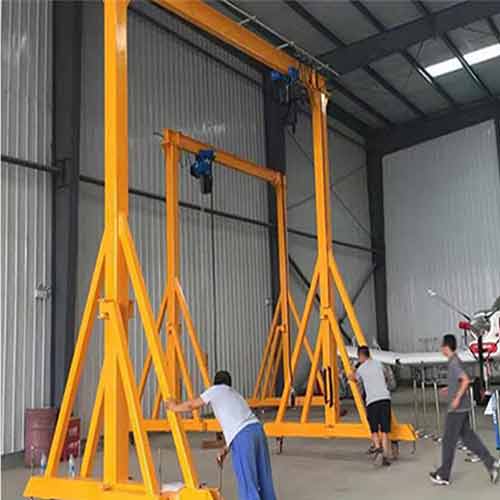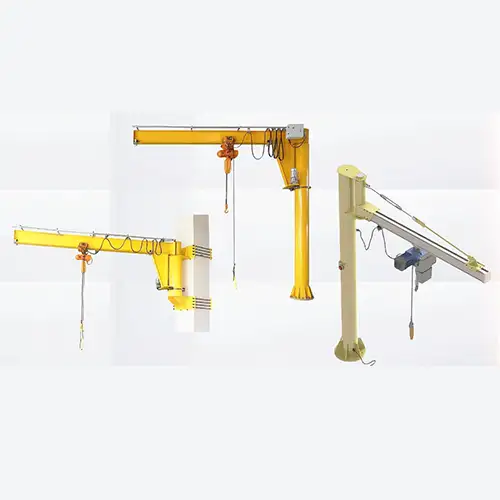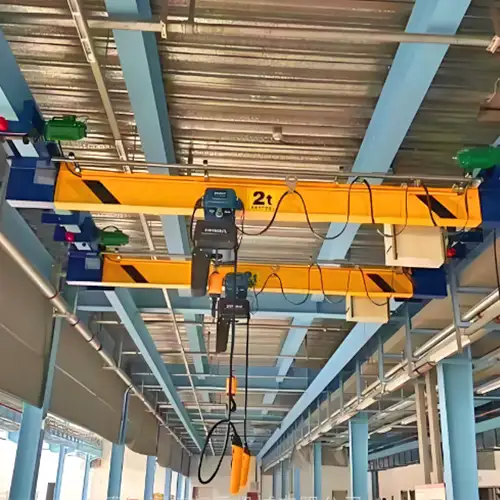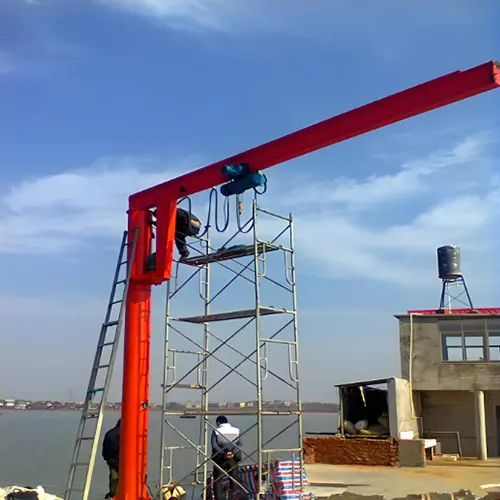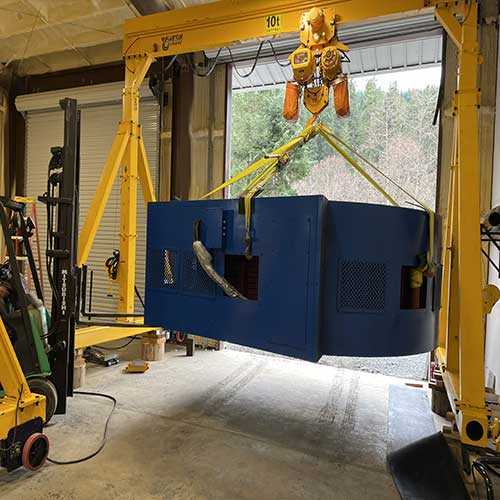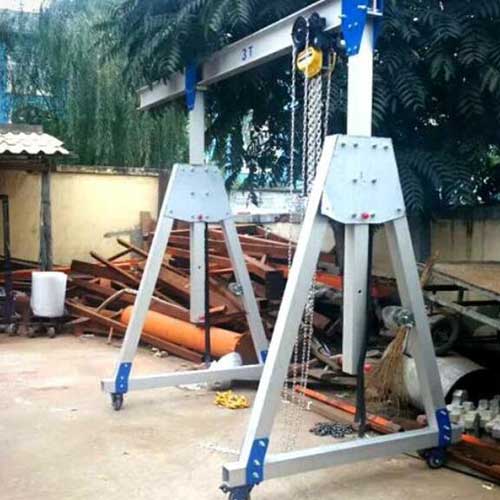Small Floor Cranes for Sale, Select Right Small Floor Cranes
Small floor cranes for sale. Various small floor cranes, i.e, floor mounted / freestanding gantry crane, jib crane & bridge crane for material handling.
Category: Small Crane
Your Trusted Small Crane Manufacturer & Supplier
Small Floor Cranes for Sale, Select Right Small Floor Cranes
All Types of Floor Mounted Small Floor Cranes & Freestanding Small Floor Cranes for Sale
Small floor cranes for sale. Various small floor cranes, i.e, floor mounted crane / freestanding gantry crane, jib crane & bridge crane for material handling.
Small Floor Cranes: Enhancing Material Handling Efficiency
In the realm of material handling and lifting solutions, small floor cranes stand as versatile and efficient tools. These compact yet robust machines have revolutionized the way industries manage their material handling needs. Designed to navigate confined spaces and manage varying loads, small floor cranes offer a comprehensive solution for businesses seeking agility, versatility, and reliability in their operations.
Compact Design, Powerful Performance: Small floor cranes, known for their compact structure, pack an impressive performance punch. Their sturdy construction, coupled with advanced features, enables them to handle various lifting tasks with precision and ease. From factories to warehouses and construction sites, these cranes prove invaluable for their ability to efficiently move heavy loads in limited spaces.
Adaptability and Versatility: What sets small floor cranes apart is their adaptability to diverse working environments. Whether it's handling heavy machinery components on a production floor or aiding in construction projects, these cranes demonstrate unparalleled versatility. Their ability to navigate through tight spaces and lift different load capacities makes them indispensable for businesses seeking flexible and efficient material handling solutions.
Streamlining Operations: Small floor cranes streamline material handling operations by offering a blend of mobility, strength, and precision. Their compact yet powerful design aids in optimizing workflow, minimizing downtime, and ensuring safety in lifting operations. These cranes contribute significantly to the efficient movement of goods, ultimately boosting productivity and operational efficiency.
In this comprehensive guide, we delve into the intricacies of small floor cranes, exploring their diverse types, applications across industries, operational insights, user concerns, and the pivotal role they play in enhancing material handling efficiency.
Defining Small Floor Cranes
Small floor cranes, although compact in size, exhibit robustness and exceptional utility in the realm of material handling. Understanding their design, functionality, and pivotal role in diverse environments is crucial.
Small floor cranes represent a compact yet formidable solution in the landscape of material handling equipment. Typically designed with a sturdy base and a telescopic boom, these cranes offer efficient lifting capabilities within confined spaces. Their functionality encompasses a balance between strength and agility, allowing for precise load handling without compromising on maneuverability.
Significance in Material Handling Tasks
The pivotal role of small floor cranes in material handling tasks extends far beyond their size. Their contributions to operational efficiency and streamlining material transport processes underscore their significance in various industries.
- Contributions to Operational Efficiency: These cranes significantly contribute to operational efficiency by offering a versatile solution for lifting and moving heavy loads with precision. Their ability to access confined spaces ensures uninterrupted material handling operations, leading to increased productivity.
- Impact on Streamlining Material Transport Processes: Small floor cranes play a crucial role in streamlining material transport processes. Their agility and ability to handle diverse loads efficiently enhance the workflow, minimizing downtime, and optimizing material movement within workspaces.
Small Floor Crane Classifications on Crane Design Structure

Floor Mounted Small Gantry Crane
- Design: Consists of two vertical legs supporting a horizontal beam (bridge). It moves along the floor-mounted rails or tracks.
- Advantages: Offers stability, mobility, and excellent lifting capabilities. Suitable for various applications and adaptable to different environments.
- Applications: Used in workshops, warehouses, and assembly lines for lifting and moving heavy loads

- Design: Utilizes a vertical mast mounted to the floor with a horizontal boom, allowing for rotation and lateral movement.
- Advantages: Occupies minimal space, provides precise maneuverability, and aids in lifting operations within confined areas.
- Applications: Ideal for workstations, machining areas, or specific work zones where localized lifting is required.

Freestanding Small Bridge Crane
- Design: Comprises a horizontal bridge supported by two parallel runways. It operates independently without the need for support from the building structure.
- Advantages: Offers significant coverage and lifting capability without reliance on building support. Suitable for standalone applications.
- Applications: Widely used in manufacturing, maintenance facilities, and warehouses for versatile lifting and material handling tasks.
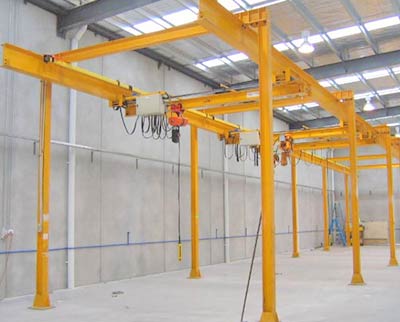
- Design: Consists of a single rail mounted to freestanding supports. The hoist and trolley move along the monorail track for lifting and moving loads.
- Advantages: Provides a simple, cost-effective solution for moving loads in a linear path. Takes up minimal floor space.
- Applications: Used in assembly lines, workshops, and storage areas for linear material handling.
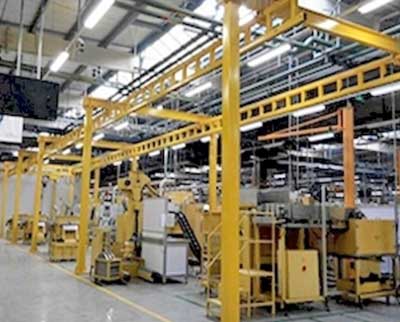
Floor Mounted Workstation Cranes
- Design: Compact cranes mounted to the floor, offering localized lifting and material handling within a limited workspace.
- Advantages: Enhances productivity in workstations, aiding in repetitive or smaller-scale lifting tasks.
- Applications: Ideal for individual workstations, machine feeding, and assembly areas where precise handling is essential.
Each of these small floor cranes possesses distinct structural designs, benefits, and specific applications, catering to different lifting requirements and operational settings. They offer efficient solutions for various industries, addressing specific material handling needs within their designated areas.
Crane Construction Materials

- Features:
- Robust Construction: Utilizes steel for sturdiness and resilience in demanding environments.
- Durability: Steel frame cranes are known for their longevity and ability to withstand heavy usage.
- Benefits:
- Strength: Offers high strength and structural integrity for heavy lifting tasks.
- Versatility: Suitable for rugged industrial applications due to its robustness.
- Applications:
- Manufacturing: Ideal for heavy-duty lifting in manufacturing plants and assembly lines.
- Warehousing: Well-suited for material handling tasks in warehouses dealing with bulkier items.

- Features:
- Lightweight Build: Utilizes aluminum for increased portability and ease of maneuverability.
- Corrosion Resistance: Aluminum's corrosion-resistant nature makes it suitable for outdoor use.
- Benefits:
- Portability: Easy to transport and set up due to its lightweight design.
- Adaptability: Suitable for both indoor and outdoor applications.
- Applications:
- Construction Sites: Ideal for lifting tasks in construction areas due to their portable nature.
- Marine Industry: Well-suited for maritime environments due to corrosion resistance.

Hybrid Floor Cranes for Clean Room
- Features:
- Combination of Materials: Blends different materials for an optimized balance of strength and weight.
- Enhanced Durability: Offers durability with a mix of sturdy materials.
- Benefits:
- Optimized Performance: Provides the advantages of both steel and aluminum in one crane.
- Versatility: Suited for a wide range of applications due to its balanced features.
- Applications:
- Varied Industries: Used in industries where versatility and adaptability are crucial.
Traveling Types

Rail-Mounted Floor Cranes
- Features:
- Precise Movement: Operates along fixed rails for accurate and controlled lifting.
- Stability: Offers stability and controlled motion for lifting operations.
- Benefits:
- Precision: Ideal for applications requiring precise positioning of heavy loads.
- Safety: Ensures secure movement and prevents accidents during material handling.
- Applications:
- Manufacturing: Suited for assembly lines where accuracy in movement is critical.

Trackless Floor Cranes
- Features:
- Independent Movement: Does not rely on fixed tracks, providing more flexible operation.
- Maneuverability: Allows movement across various surfaces without restrictions.
- Benefits:
- Versatility: Offers more adaptability in different work environments.
- Ease of Use: Simplifies material handling tasks without the need for fixed infrastructure.
- Applications:
- Warehousing: Ideal for dynamic warehouse layouts where tracks may not be practical.

Battery-Powered Floor Cranes
- Features:
- Rechargeable Batteries: Operates using rechargeable batteries for enhanced mobility.
- Environmental Friendliness: Reduces emissions and noise pollution compared to other power sources.
- Benefits:
- Mobility: Provides flexibility in movement without being tethered to power sources.
- Sustainability: Offers an eco-friendly alternative for material handling tasks.
- Applications:
- Indoor and Outdoor: Suitable for both indoor and outdoor applications without relying on power outlets.
Load Capacity

Light-Duty Floor Cranes
- Features:
- Designed for Lighter Loads: Suitable for smaller-scale lifting operations.
- Compact Size: Occupies less space and offers maneuverability.
- Benefits:
- Versatility: Handles lighter loads with ease, ideal for smaller tasks.
- Accessibility: Easily maneuverable in confined spaces.
- Applications:
- Workshops: Perfect for lifting smaller machinery and components.
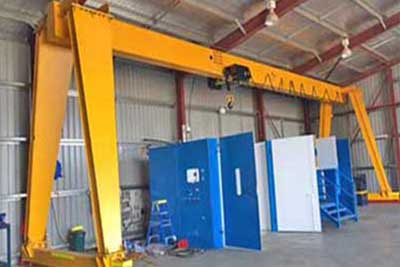
- Features:
- Moderate Load Capacity: Capable of handling moderate loads in various settings.
- Balanced Performance: Offers a mix of strength and agility.
- Benefits:
- Versatility: Suitable for various industrial applications requiring moderate lifting.
- Efficiency: Provides a balance between load capacity and maneuverability.
- Applications:
- Manufacturing: Used for lifting medium-sized components or machinery.
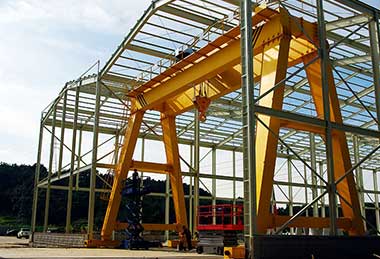
- Features:
- High Load Capacity: Built to handle heavier loads in demanding environments.
- Robust Construction: Engineered for heavy-duty applications.
- Benefits:
- Strength and Power: Lifts heavier materials or equipment efficiently.
- Durability: Withstands demanding tasks in rugged settings.
- Applications:
- Construction Sites: Perfect for lifting large building materials or machinery.
Each type of small floor crane caters to different needs, offering various advantages and applications in industrial, construction, and material handling settings. The choice depends on specific operational requirements and the nature of tasks to be performed.
Versatility in Material Handling
Mobility and Maneuverability
Agile Movement Capabilities in Confined Spaces
Small floor cranes are designed to navigate through restricted or confined spaces with ease. Their compact size and maneuverability allow them to operate efficiently in areas where larger equipment might struggle to reach. This agility is crucial in environments where space is limited, enabling precise material handling without compromising safety or obstructing workflow.
Versatility in Adapting to Diverse Material Handling Tasks
These cranes showcase remarkable versatility in adapting to various material handling tasks. They're adept at lifting, transporting, and positioning a wide array of loads, from heavy machinery components to fragile goods. Their flexibility in accommodating different load types, shapes, and sizes makes them indispensable across industries requiring adaptable material handling solutions.
Lifting Capacities and Adaptability
Range of Lifting Capacities and Load Handling
Small floor cranes offer a diverse range of lifting capacities, catering to different load requirements. They are capable of lifting loads ranging from a few hundred pounds to several tons, depending on the specific model and design. This wide lifting capacity spectrum allows for versatility in handling both light and heavy loads effectively.
Adaptability to Various Industries and Material Types
These cranes demonstrate adaptability across diverse industries and material types. Whether it's in manufacturing, construction, warehouses, or assembly lines, their adaptability allows them to handle materials ranging from raw materials to finished products. They can accommodate materials of various shapes, sizes, and weights, making them versatile solutions for a multitude of applications.
Practical Applications and Use
Industrial Applications
Use in Manufacturing and Production Environments
Small floor cranes play a pivotal role in manufacturing and production environments by facilitating various material handling tasks. They are instrumental in lifting heavy machinery components, transferring materials along assembly lines, and positioning goods during the manufacturing process. Their versatility aids in expediting production processes while ensuring precise and efficient material handling.
Enhancing Efficiency in Warehouses and Assembly Lines
Within warehouses and assembly lines, small floor cranes optimize space utilization and streamline material movements. They efficiently load and unload items onto storage shelves, aid in inventory management, and assist in assembling products. Their ability to navigate in confined spaces and lift loads to specific heights enhances overall warehouse efficiency, minimizing downtime and maximizing productivity.
Construction and Field Operations
Utility in Construction Sites and Field Material Handling
In construction, these cranes serve as indispensable tools for lifting and placing construction materials, equipment, and tools at various work sites. They provide support in tasks such as erecting structural components, transporting heavy building materials, and assisting in the installation of fixtures. Their portability and adaptability make them versatile companions in dynamic construction environments.
Role in Facilitating On-Site Tasks and Operations
Small floor cranes facilitate a range of on-site tasks in field operations, including maintenance, repairs, and installations. They aid in handling and positioning equipment, assisting technicians in complex repair or maintenance procedures, and maneuvering heavy loads within field settings. Their ease of setup and functionality make them valuable assets in executing diverse on-site operations efficiently.
Considerations and Operational Insights
Safety Measures and Operational Guidelines
Importance of Safety Features and Compliance
Small floor cranes are equipped with various safety features, such as overload protection, emergency stop buttons, limit switches, and audible alarms. These features ensure safe operation by preventing accidents due to overload, providing emergency shutdown options, and alerting operators about potential hazards. Compliance with safety standards and regulations ensures the cranes meet industry safety requirements, minimizing risks during operations.
Operational Guidelines Ensuring Safe Handling Practices
Operators must adhere to operational guidelines provided by manufacturers to ensure safe handling practices. Proper training in crane operation, load capacity awareness, correct attachment techniques, and understanding the equipment's limitations are essential. Regular safety inspections, pre-operation checks, and adherence to established safety protocols contribute significantly to accident prevention and secure material handling operations.
Maintenance and Durability
Maintenance Protocols for Longevity and Optimal Performance
Adhering to maintenance protocols is crucial for maintaining the longevity and optimal performance of small floor cranes. Regular inspections, lubrication of moving parts, and periodic checks on electrical components ensure smooth operation. Scheduled maintenance routines, as outlined in the manufacturer's manual, help identify and rectify potential issues before they escalate, minimizing downtime and extending the crane's service life.
Durability Features and Long-Term Reliability
Small floor cranes are constructed using durable materials, such as high-strength steel or aluminum alloys, ensuring long-term reliability. These materials offer corrosion resistance and robustness, contributing to the crane's durability and ability to withstand demanding operational environments. Their sturdy construction and quality components make them reliable assets for continuous material handling operations.
User Concerns and Solutions
Frequently Encountered Questions:
How can I maneuver the crane in tight spaces?
Solution: Offer guidance on using multi-directional controls, emphasizing load positioning techniques, and suggesting alternative lifting methods suitable for limited spaces.
What are the functionalities of the control systems, and how do I operate them?
Solution: Provide comprehensive tutorials or interactive guides explaining control functions, operation modes, and safety features to enhance user understanding.
How can I adapt the crane to varying environmental conditions?
Solution: Offer insights into environmental factors affecting crane operation, and suggest appropriate adjustments or precautions to optimize performance in different conditions.
Frequently Encountered Problems:
Difficulty in maneuvering within confined spaces:
Solution: Offer strategies such as load positioning guidance, multi-directional controls, or alternative lifting techniques to assist users in navigating limited spaces.
Complexity in understanding control systems:
Solution: Provide detailed tutorials or interactive guides explaining control functions, operation modes, and safety features to improve users' comprehension and operational efficiency.
Adapting the crane to specific environmental constraints:
Solution: Offer insights into how environmental factors affect crane operation and suggest adjustments or precautions to ensure adaptability to varying conditions.
Top Concerns:
Operational Efficiency: Users often aim to maximize the efficiency of crane operations within limited space and varying conditions.
Solution: Offer guidance on operational techniques, load positioning, and alternative lifting methods to enhance efficiency.
Safety Measures: Safety is a top concern when operating equipment, especially in industrial settings.
Solution: Emphasize safety protocols, control system functionalities, and the importance of regular maintenance for optimal safety.
Adaptability to Diverse Tasks: Users might face challenges in adapting the crane to different material handling tasks.
Solution: Provide guidelines on the crane's versatility, adaptability to various loads, and suitable applications for different industries.
By addressing these frequently encountered questions, problems, and concerns with practical solutions and comprehensive guidance, users can effectively operate small floor cranes, ensuring safety, efficiency, and adaptability in diverse work environments.
After-Sales Support and Services
Customer-Centric After-Sales Support:
Troubleshooting Assistance:
- 24/7 Technical Support: Offer round-the-clock assistance to address any operational or technical issues users may encounter with the crane.
- Remote Troubleshooting: Provide remote diagnostic support to quickly identify and resolve problems, minimizing downtime.
Training and Guidance:
- Training Programs: Conduct training sessions for users on crane operation, safety protocols, and maintenance, ensuring they are well-equipped to handle the equipment efficiently.
- User Manuals and Guides: Supply comprehensive user manuals and guides that cover operational procedures, troubleshooting steps, and safety instructions.
Spare Parts Availability:
- Prompt Spare Parts Delivery: Ensure the availability and prompt delivery of genuine spare parts to minimize downtime in case of part replacements or repairs.
- Scheduled Maintenance Plans: Offer scheduled maintenance plans and reminders to users to ensure the crane operates optimally over time.
Services Ensuring Continuous Operational Efficiency:
Maintenance Services:
- Regular Maintenance Checks: Schedule periodic maintenance checks by qualified technicians to ensure the crane's continued efficiency and reliability.
- Proactive Maintenance Alerts: Provide alerts or notifications to users for scheduled maintenance, ensuring the crane's optimal performance.
Upgrades and Customization:
- Upgrade Services: Offer options for upgrades or enhancements to the crane's capabilities or features based on evolving user needs or technological advancements.
- Customization Possibilities: Provide customization options to tailor the crane according to specific user requirements or industry standards.
Performance Monitoring:
- Remote Monitoring Systems: Offer remote monitoring systems to track the crane's performance, allowing for early detection of potential issues.
- Performance Analytics: Provide data-driven insights and analytics about crane usage, aiding users in optimizing operations and improving efficiency.
By ensuring robust after-sales support, continuous operational efficiency services, and proactive maintenance, crane manufacturers demonstrate their commitment to customer satisfaction and the reliability of their products, reassuring potential buyers of ongoing support and service excellence.
Contact to Get Your Small Floor Cranes for Effective Material Handling
Small floor cranes have emerged as indispensable tools in the realm of material handling, offering unmatched versatility and efficiency. Their compact yet powerful design, combined with a myriad of features and adaptability, makes them a cornerstone in diverse industrial and operational settings.
Summarizing the Utility and Benefits: Small floor cranes encapsulate a multitude of benefits. From their compact design to their impressive lifting capacities, these cranes stand as efficient solutions for various material handling tasks. Their agility in confined spaces, along with the adaptability to different material types, underscores their utility in numerous industrial applications.
Reinforcing their Role in Streamlining Material Handling Tasks: The unparalleled efficiency offered by small floor cranes is instrumental in streamlining material handling processes across industries. From manufacturing facilities and warehouses to construction sites, these cranes play a pivotal role in enhancing productivity, optimizing workflows, and ensuring safe and efficient material transportation.
In essence, the versatility, adaptability, and efficiency of small floor cranes make them indispensable assets in modern-day material handling operations. As the demands for agile and efficient handling solutions continue to rise, these cranes stand tall as dependable allies in meeting and exceeding operational expectations.
Main Projects
Related Products

Supplied three grab bucket crane kits to Indonesia, enhancing garbage handling efficiency with high load capacity and reliable performance.
Free consultation to Confirm Parameters & Specifications and Get
Latest Crane Price & Crane Rate.
- Types of overhead cranes : _______?
- Optional: Overhead travelling crane, goliath gantry crane,Slewing jib crane, Single girder or double girder crane,small portable crane or kbk crane, etc.
- Capacity of overhead crane: _______?
- Optional: 0.25ton, 0.5 ton, 1 ton, 2 ton, 3ton, 5 ton, 10 ton,15ton, 20ton, 25 ton, 30ton,35ton, up to 550ton, etc.
- Crane span & lifting height : _______?
- Crane travelling length : _____?
- Control of overhead crane:_______?
- Optional: pendant/ remote/cabin control
- Voltage supply of overhead crane:_____?
- Eg,: 380V50/60HZ,3Phase or others,etc.
- Application/usage of crane:_______?
- Eg,: Steel mill, ,injection mold, cement,stone, concrete,granite, general manufacturing, etc.
Just leave a message via the contact form and our hoist and crane engineer will contact you with in 24working hours.
Get In Touch
